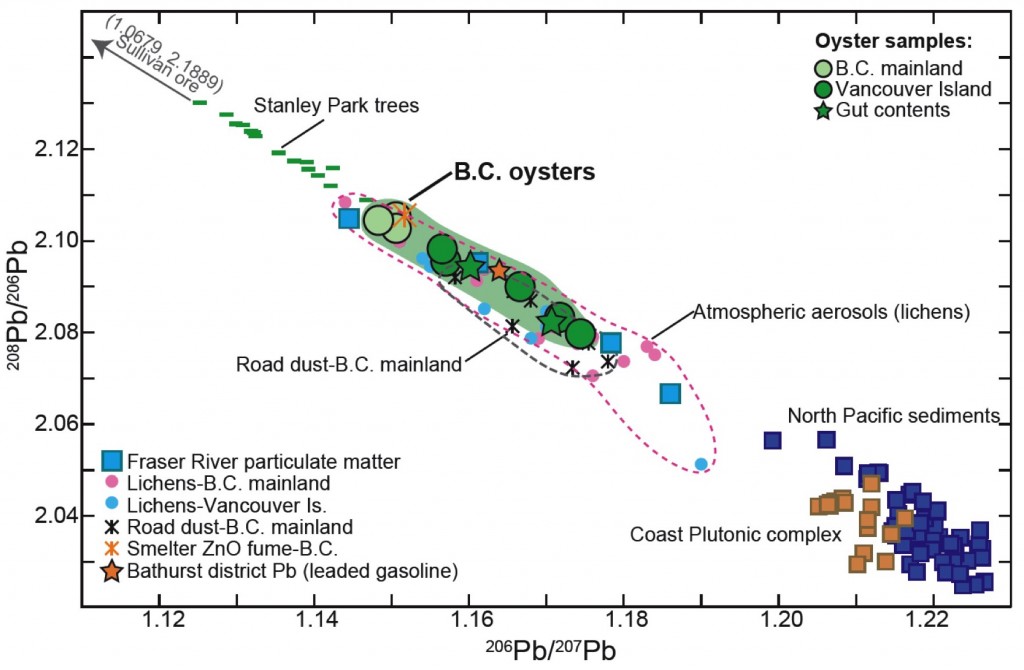The introduction of the MC-ICP-MS has allowed for the rapid growth and development of a new area of research—heavy element stable isotope geochemistry. These instruments allow for the precise determination of natural variations in the isotopic compositions of a range of heavy elements, where knowledge of such variation was previously limited because of the lower ionization efficiency of the thermal-ionization source.
With these new analytical capabilities, it is possible to undertake the challenge of deciphering the processes that produce these fractionations and use these isotopic tools in a variety of scientific fields.
Dominique has used the fingerprinting capability of Pb isotopes as a tracer of pollution. Combined with transitional isotope systems (Cd and Zn), she has mapped the dispersion of refinery plumes into neighbouring towns and the environment (Deboudt et al., 1999; Franssens et al., 2004; Mattielli et al., 2009; Shiel et al., 2010). Alternatively, a study showed that high Cd contents in oysters from the west coast of North America were related to natural sources, signifying the importance of upwelling on Cd contents (Shiel et al., 2012).
In comparison to some key locations in France, historical pollution events with long persistence in rivers, sediments and ponds, are shown to be directly correlated to the high Cd contents in oysters (Shiel et al., 2013).

These results demonstrate the usefulness of Cd and Zn isotopes as environmental tracers, and the methods developed through this research will be applied to further study the environment. For example, Dominique is now using Zn and Mo isotopes to study the mobility and fate of metals in mining waste rock piles (PhD, Elliott Skierszkan), and the fate of molybdenum in an anoxic fjord off the coast of Vancouver Island (PDF, Dr. E. King).
Since 2015, Dominique has been involved in a study of the trace metal contents and Pb isotopic compositions of honey from the Greater Vancouver area, in partnership with the non-profit organization Hives for Humanity. This organization has professional beekeepers who look after hives throughout the city, and supports local sustainable economies and at-risk communities through beekeeping activities. The research to date has traced the likely source of Pb to human impact, since Pb isotope signatures do not match those of the local geology.
This work has led to the creation of UBC’s BeeHIVE Research Excellence Cluster (Bee Health, Impact and Value on the Environment), the publication of an article by Smith et al. (2019) in Nature Sustainability, and local and international media attention (e.g., The Conversation, The New York Times). Dominique has also analyzed Pb concentrations and isotopes in tree rings to trace the history of lead pollution in Vancouver over the last 200 years.
Li, M. et al. (2020) Assessing lead sources in fishes of the northeast Pacific Ocean. Anthropocene, 29: 100234.
Smith, K.E. et al. (2019) Honey as a biomonitor for a changing world. Nature Sustainability, 2: 223–232.
Shiel, A.E. et al. (2019) Geochemistry of heavy metal isotopes: tracers of anthropogenic source and environmental footprint. In: Eglington B. et al. (eds.), Applied Isotope Geochemistry. MAC Topics in Mineral Sciences, 48: 155–172. ISSN 2561-6374, ISBN: 978-0-921294-62-7.
Skierszkan, E.K. et al. (2019) Tracing molybdenum attenuation in mining environments using molybdenum stable isotopes. Env. Sci. Tech., 53: 5678–5686.
Skierszkan, E.K. et al. (2019) Molybdenum stable isotope fractionation during the precipitation of powellite (CaMoO4) and wulfenite (PbMoO4). Geochim. Cosmochim. Acta, 244: 383–402.
Cornélis J-T. et al. (2019) Past and current geochemical conditions influence silicon isotope signatures of pedogenic clay minerals at the soil profile scale, Ethiopia. Chemical Geology, 524: 174–183.
Skierszkan E.K. et al. (2017) Molybdenum (Mo) stable isotopic variations as indicators of Mo attenuation in mine waste-rock drainage. Applied Geochemistry, 87: 71–83.
Zheng, W. et al. (2016) Mercury isotope compositions across North American forests. Global Biogeochem. Cycles, 30: 1475–1492.
Skierszkan, E.K. et al. (2016) Molybdenum and zinc stable isotope variation in mining waste rock drainage and waste rock at the Antamina mine, Peru
Skierszkan, E.K. et al. (2015) A practical guide for the design and implementation of the double-spike technique for precise determination of molybdenum isotope compositions of environmental samples. Analytical and Bioanalytical Chemistry, 407: 1925–1935.
Cornélis, J.-T. et al. (2014) Silicon isotopes record dissolution and re-precipitation of pedogenic clay minerals in a podzolic soil chronosequence. Geoderma, 235–236: 19–29.
Shiel, A.E. et al. (2013) Determining provenance of marine metal pollution in French bivalves using Cd, Zn and Pb isotopes. Geochim. Cosmochim., 121: 155–167.
Shiel, A.E., et al. (2012) Tracing cadmium, zinc and lead pollution in bivalves from the coasts of western Canada and the USA using isotopes. Geochim. Cosmochim., 76: 175–190.
Shiel, A.E. et al. (2010) Evaluation of zinc, cadmium and lead isotope fractionation during smelting and refining. Science of the Total Environment: 408: 2357–2368.
Matielli, N. et al. (2009) Zn isotope study of atmospheric emissions and dry depositions within a 5-km zone around a Pb-Zn refinery. Atmospheric Environment, 43: 1265–1272.
Flament, P. et al. (2008) Iron isotopic fractionation in industrial emissions and urban aerosols. Chemosphere, 73: 1793–1798.